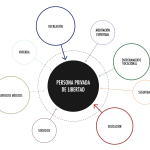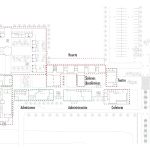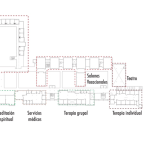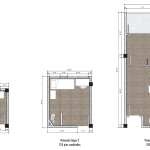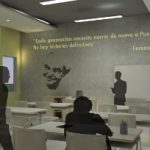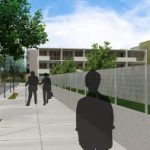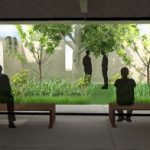Repensar el [encierro]: la prisión como Centro de Reeducación
(Rethinking [confinement]: the prison as a Reeducation Center)
““.
Designer: Jean A. Vidal De León
Thesis Director: Arch. Andrés Mignucci Giannoni
Consultants: Arch. Manuel Bermúdez García y Lilliana Ramos Collado
Project Date: May 15, 2019
Location: Ciudad Deportiva Roberto Clemente – Carolina, Puerto Rico
TOS[er]: Adelmarys Sánchez Rodríguez
Post Date:
The physical damage in the island’s correctional system and the percentage of population found inside these prisons, serve as a crude example of how the environment they are forced to live in does not help or motivate them to get educated and become better integrated into society. In jean’s thesis, the main goal is to study the irregularities in the system and how it affects those deprived of their liberty due to their own wrongdoings as a way of punishment. Getting to the root of the problem will highlight how these facilities are failing as well as gives a clearer idea of what is needed for the facilities to support rehabilitation rather than the passive storage of human beings who are paying the consequences of their wrongdoings.
Jean’s project challenges the island’s correctional system and the services and support that the inmates receive. Rethinking [confinement] offers an alternative architecture that could enhance and grow with those serving out their sentences; preparing them properly for when they return to society. As Jean studies the existing correctional system specifically, one factor that often come up is the harsh treatment inmates receive while inside. Under these circumstances the lack of motivation intersects with harsh treatment and a negative physical-environmental leading to a stalemate. It is obvious that these facilities have no intention of improving the behavior and lifestyle of their inmates, otherwise they would be offered training and other support services to help the inmates reintegrate into society. The financial impact is one of the primary reasons for not including such services as part of prison management initiatives. Meaning the system will nonchalantly disregard each persons’ needs and choose the bigger picture, although it will cost providing the necessary resources to cover basic and specific needs. This brings us to the next point: education.
Jean sees the issue of education is vital and concludes from his research that, “To improve the correctional system, the theories that should govern the system should primarily focus on education.” (Para mejorar el sistema correccional, las teorías que deben regir el sistema deben enfocarse principalmente en la educación.)
The actual system is limited to punishment rather than education. As part of the proposal, multiple activities are added to the experience of an inmate such as: sports, education, vocational training, natural environments, etc. These elements help humanize the inmates experience as well as prepare them for the “real world.” This not only benefits the prisoners, but the employees and professionals as well since the facility will become a place of growth and overcoming.
Eventually, this has the potential of lowering the rate of inmates imprisoned yearly. The ultimate goal is to break how the actual system runs and to become an enabler for innovative beliefs and ideologies. Prisons could become wellness centers, and the people who must experience it can be educated and taught to work on and for themselves. But how is this in any way related to architecture? Architecture plays an especially significant role. Instead of being a place of sole punishment, it can communicate the desire for each inmate to initiate a journey of improvement. Rethinking Enclosure is open to growth; it will never reach a final phase. It must always be open to change and expansion as per the needs of the particular inmate during their stay in the space.
For this hypothesis, Jean takes into consideration two potential locations where he will design a correctional facility that take his recommendations into account. Each one will be studied following five parameters he established and understood where necessary for the design process: context, land, accessibility, flora, and the state of property. The idea is to design places that respond to what is already there, where nature is very present and that can accommodate outdoor recreational activities. He emphasizes the need for the designed to be integrated into a community. Placing them into the periphery of inhabited enclaves does not promise to have a positive outcome either; and, contrary to common misconceptions, it will do them good and help keep them relevant to society.
Jean also identifies the need for an open space where the project can keep developing and growing. For Jean, architecture of these facilities must include sufficient flexibility so that the space may grow with the person as a metaphor of their inner progress. Therefore, to solve this problem, Jean choses to study precedents focused on the evolution of architecture and the person’s growth as well.
SJean’s proposal for a “new prison system,” responds to each individual’s personal growth. He starts with an open concept where educational spaces become the primary areas. As the inmate’s grow within the system, they shift to cells that accommodate their new skills. Each model is substantially bigger and more complex than the prior one as a reward for the inmate’s personal and educational development; architecture becomes a means of motivation. As for the nature aspect of the project, Jean ensured that it is present throughout the design.
TOS[er] reaction:
It is unusual to see topics like this openly talked about, even though it plays an important role in society. This thesis is valuable and relevant in this age and era, considering how a system that has been active for hundreds of years has never seen any substantial change or improvement, especially for those who must go through it. Although these facilities were originally designed to correct those who have done wrong, instead they have become a hopeless place of endless punishment and suffering where humans are treated as animals. The prison system is broken and in severe need of an immediate update and change. Given these circumstances, Jean’s proposal advocates for greater humanity with a profound commitment to improve the inmate’s sense of progress and reintegration into society. (or as he calls them, “population deprived of liberty”) life.


